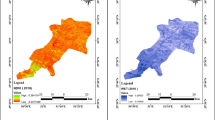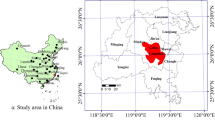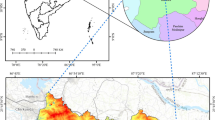Abstract
This paper presents a method of map** and monitoring ecological quality and environmental change using an ecological evaluation model (EEM), which is based on remote sensing data of the Pearl River Delta region in Guangdong, China. Five geographical indices were selected: Impervious Surface, Normalized Difference Vegetation Index, Land Surface Temperature, and Greenness and Brightness generated from the Tasseled Cap Transformation. These geographical indices are of ecological significance and they were used as variables to build the EEM through factor analysis. In addition, land use maps derived from remote sensing data were overlaid on these five index maps to analyze the effects of land use change on ecological status. Based on the EEM values, five levels of ecological zones were identified using a standard-deviation segmenting method. The results showed that the areas of the first and second levels decreased significantly, those of the third and fourth levels increased, and the area of the fifth level remained unchanged. It was established that the remote sensing method is practical for the analysis of ecological change, thus this work could be considered a case study for other ecological monitoring research.









Similar content being viewed by others
References
Alcamo J, van Vuuren D, Cramer W (2005) Changes in ecosystem services and their drivers across the scenarios. In: Carpenter SR, **ali PL, Bennett EM, Zurek MB (eds) Ecosystems and human well-being, Scenarios, findings of the Scenarios Working Group, Millennium Ecosystem Assessment. Island Press, Washington, pp 297–373
Aldwaik S, Pontius R (2012) Intensity analysis to unify measurements of size and stationarity of land changes by interval. Landsc Urban Plan 106(1):103–114
Arvid B, Andreas Z (2013) To model the landscape as a network: a practitioner’s perspective. Landsc Urban Plan 119:35–43
Asmala A, Shaun Q (2012) Analysis of maximum likelihood classification on multispectral data. Appl Math Sci 6(129):6425–6436
Belton V, Stewart T (2001) Multiple criteria decision analysis: an integrated approach. Kluwer Academic, Boston
Bradley AM, William GC, van der Valk AG (2009) Spatial distribution of historical wetland classes on the Des Moines Lobe, Iowa. Wetlands 29(4):1146–1152
Carvalho-Santos C, Marcos B, Espinha MJ, Alcaraz-Segura J, Hein LG, Pradinho HH (2013) Evaluation of hydrological ecosystem services through remote sensing. Earth Observation of Ecosystem Services, CRC Press Taylors and Francis group, Boca Raton, pp 229–260
Daniel CH, Chein-I C (2001) Fully constrained least squares linear spectral mixture analysis method for material quantification in hyperspectral imagery. IEEE Trans Geosci Remote Sens 39(3):529–545
De Keersmaecker W, Lhermitte S, Honnay O, Farifteh J, Somers B, Coppin P (2014) How to measure ecosystem stability? An evaluation of the reliability of stability metrics based on remote sensing time series across the major global ecosystems. Glob Change Biol 47(20):2149–2161
De Keersmaecker W, Lhermitte S, Tits L, Honnay O, Somers B, Coppin P (2015) Resilience and the reliability of spectral entropy to assess ecosystem stability. Glob Change Biol. doi:10.1111/gcb.12799
Fan F, Wang Y, Wang Z (2008) Temporal and spatial change detecting (1998–2003) and predicting of land use and land cover in Core corridor of Pearl River Delta (China) by using TM and ETM+ images. Environ Monit Assess 137(1–3):127–147
Fan F, Wang Y, Qiu M, Wang Z (2009) Evaluating the temporal and spatial urban expansion patterns of Guangzhou from 1979 to 2003 by remote sensing and GIS methods. Int J Geogr Inf Sci 23(11):1371–1388
Foley JA, De Fries R, Asner GP, Barford C, Bonan G, Carpenter SR et al (2005) Global consequences of land use. Science 309:570–574
Grice J (2001) Computing and evaluating factor scores. Psychol Methods 6:430–450
Groom G, Mucher C, Ihse M, Wrbka T (2006) Remote sensing in landscape ecology: experiences and perspectives in a European context. Landscape Ecol 21(3):391–408
Huang J, Pontius J, Robert G, Li Q, Zhang Y (2012) Use of intensity analysis to link patterns with processes of land change from 1987 to 2007 in a coastal watershed of southeast China. Appl Geogr 34:371–384
Inghe O (2001) The Swedish landscape monitoring programmer: current status and prospects for the near future. In: Groom G, Reed T (eds) Strategic landscape monitoring for the Nordic countries (Tema Nord 2001:523). Nordic Council of Ministers, Copenhagen, pp 61–67
Jonathan AF, Ruth DF, Gregory PA, Carol B, Gordon B, Stephen RC, Chapin FS, Michael TC et al (2005) Global consequences of land use. Science 309:570–574
Kaiser H, Cerny B (1979) Factor analysis of the image correlation matrix. Educ Psychol Meas 39:711–714
Kauth RJ, Thomas GS (1976) The tasselled cap—a graphic description of the spectral-temporal development of agricultural crops as seen by LANDSAT. LARS Symposia, Paper 159
Kerr J, Ostrovsky M (2003) From space to species: ecological applications for remote sensing. Trends Ecol Evol 18(6):299–305
Li J, Song C, Cao L, Zhu F, Meng X, Wu J (2011) Impacts of landscape structure on surface urban heat islands: a case study of Shanghai, China. Remote Sens Environ 115:3249–3263
Liu H, Weng Q (2008) Seasonal variations in the relationship between landscape pattern and land surface temperature in Indianapolis. Environ Monit Assess 144:199–219
Luck M, Wu J (2002) A gradient analysis of urban landscape pattern: a case study from the phoenix metropolitan region, Arizona. USA Landsc Ecol 17(4):327–339
Pontius J, Robert G, Emily S, Menzie M (2004) Detecting important categorical land changes while accounting for persistence. Agric Ecosyst Environ 101(2–3):251–268
Pontius J, Robert G, Marco M (2011) Death to Kappa: birth of quantity disagreement and allocation disagreement for accuracy assessment. Int J Remote Sens 32(15):4407–4429
Qin Z, Karnieli A, Berliner P (2001) A mono-algorithm for retrieving land surface temperature from Landsat TM data and its’ application to the Israel–Egypt border region. Int J Remote Sens 18:583–594
Roberts DA, Batista GT, Pereira ILG, Waller EK, Nelson BW (1998) Change identification using multitemporal spectral mixture analysis: applications in eastern Amazonia. In: Lunetta RS, Elvidge CD (eds) Remote sensing change detection: environmental monitoring methods and applications. Taylor and Francis Ltd, London, pp 137–158
Singh SK, Srivastava PK, Gupta M, Thakur JK, Mukherjee S (2014) Appraisal of land use/land cover of mangrove forest ecosystem using support vector machine. Environ Earth Sci 71(5):2245–2255
Srivastava PK, Han D, Rico-Ramirez MA, Bray M, Islam T (2012) Selection of classification techniques for land use/land cover change investigation. Adv Space Res 50(9):1250–1265
Srivastava PK, Han D, Rico-Ramirez MA, Bray M, Islam T, Gupta M, Dai Q (2014a) Estimation of land surface temperature from atmospherically corrected LANDSAT TM image using 6S and NCEP global reanalysis product. Environ Earth Sci. doi:10.1007/s12665-014-3388-1
Srivastava PK, Mehta A, Gupta M, Singh SK, Islam T (2014b) Assessing impact of climate change on Mundra mangrove forest ecosystem, Gulf of Kutch, western coast of India: a synergistic evaluation using remote sensing. Theoret Appl Climatol 72:5183–5196
Stevens J (2002) Applied multivariate statistics for the social sciences, 4th edn. Lawrence Erlbaum Associates, Mahwah
Tabachnick B, Fidell L (2001) Principal components and factor analysis. In using multivariate statistics, 4th edn. Allyn & Bacon, Needham Heights, pp 582–633
Thomas IL, Ching NP, Benning VM, D’Aguanno JA (1987) A review of multi-channel indices of class separability. Int J Remote Sens 8(3):331–350
Thomas V, Treitz P, Jelinski D, Miller J, Lafleur P, McCaughey JH (2002) Image classification of a northern peatland complex using spectral and plant community data. Remote Sens Environ 84(1):83–99
Turner M (2005) Landscape ecology in North America: past, present and future. Ecology 86(8):1967–1974
Wang K, Franklin S, Guo X, Cattet M (2010) Remote sensing of ecology, biodiversity and conservation: a review from the perspective of remote sensing specialists. Sensors 10(11):9647–9667
Weng Q (2002) Land use change analysis in the Zhujiang Delta of China using satellite remote sensing, GIS and stochastic modeling. J Environ Manag 64:273–284
Williams B, Brown T, Onsman A (2010) Exploratory factor analysis: a five-step guide for novices. Australas J Paramed 8(3):1–13
Worley J, Vassar M, Wheeler D, Barnes L (2008) Factor structure of scores from the maslach burnout inventory: a review and Meta analysis of 45 exploratory and confirmatory factor analytic studies. Educ Psychol Measur 68:797–823
Zhang J, Wang Y (2008) Study of the relationships between the spatial extent of surface urban heat islands and urban characteristic factors based on Landsat ETM+ data. Sensors 11(8):7453–7468
Zhang J, Wang Y, Li Y (2006) A C++ program for retrieving land surface temperature from the data of Landsat TM/ETM+ b and 6. Comput Geosci 32(10):1796–1805
Zhang J, Wang Y, Wang Z (2007) Change analysis of land surface temperature based on robust statistics in the estuarine area of Pearl River (China) from 1990 to 2000 by Landsat TM/ETM + data. Int J Remote Sens 28(10):2383–2390
Acknowledgments
This work was supported by the National Nature Science Foundation of China (Grant No.: 41201432), Science and Technology Planning Project of Guangdong Province (2014A070711020), National Special Program on Basic Works for Science and Technology of China (No. 2013FY110900), Natural Science Foundation of Guangdong Province, China (Grant No.: S2013010014097).
Author information
Authors and Affiliations
Corresponding author
Rights and permissions
About this article
Cite this article
Zhang, J., Zhu, Y. & Fan, F. Map** and evaluation of landscape ecological status using geographic indices extracted from remote sensing imagery of the Pearl River Delta, China, between 1998 and 2008. Environ Earth Sci 75, 327 (2016). https://doi.org/10.1007/s12665-015-5158-0
Received:
Accepted:
Published:
DOI: https://doi.org/10.1007/s12665-015-5158-0




